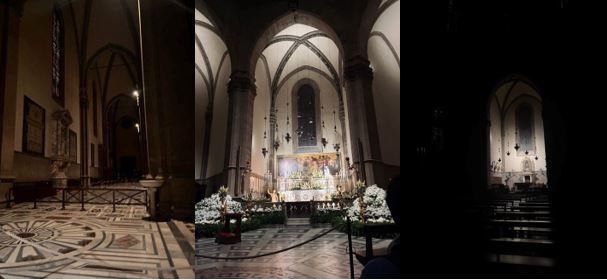
By Sophia Stokoe, Syracuse University
This is an excerpt of a travelogue produced for Professor Isabella Martini’s class Fictional Tuscany: Travel through Text. The assignment asked students to reflect on a site visit in Florence or a trip elsewhere in Tuscany, either a Syracuse Florence field trip or a destination they explored on their own, enriching it with their own research of the site.
While I’ve been rewriting my understanding of Florence, simultaneously, the city has in turn changed who I am as a person…While my anxiety is still present, I adapted to Italian culture and have become more relaxed. The uncertainty of the situations I’ve had to encounter, especially those with a language barrier, have also forced me to be more adaptable which in turn has increased my confidence in Italy.
My original personality never left but there’s now a quiet confidence that has deeply changed how I interact with the world…I know for a fact that I would not have been able to change if not for the moments of solitude I’ve had in Florence. When one is exploring a place with family or friends, they’re often too busy talking to each other to notice all of the smaller details on that place. I’ve had many moments alone with the city mentally tracing the architecture and people watching.
While I’ve had a multitude of moments doing so in several piazzas; one of my best solo observational moments was partially planned. My introductory Italian professor had told my class about how Italians celebrate the Thursday before Easter by visiting multiple churches. The day itself is known as Santo Giovedì while Easter is called Pasqua. Florence specifically is known for the tradition of visiting seven churches the night of Santo Giovedì. While I personally am not a spiritual person, I decided to visit some of the churches in the area as a way of participating in Florentine tradition.
The first stop on my list surprisingly turned out to be my favorite out of the 4 churches that I visited that night. I explored the Duomo, Santa Croce, San Lorenzo, and Santa Maria Novella. I went into the Duomo with standard expectations, as I had gone before during the day and knew what the interior looked like. However, the inside of the cathedral was absolutely breathtaking in the dark. The little bit of light from the occasional candle crept up the arches and dimly lit the surroundings just enough to be able to navigate the building, while still leaving enough room for shadows to adorn the walls.
People had begun to gather around the painting of the last supper, all talking in hushed voices. I didn’t hear a single word of English and did not dare speak myself without reason. I don’t think I said anything out loud that night until I returned home. Yet I did have to stop myself from chuckling as I made out a conversation of a couple of children talking about wanting dinner. I spent a while in one of the pews taking in the surrounding atmosphere. The energy inside along with the overpowering silence had me in a more contemplative mood and I felt the most spiritual I had ever been. It wasn’t as tied to Catholicism and more so to a general spirituality, but I felt rooted to the moment and to the place by maintaining that silence myself. In hindsight, it reminds me of L’infinito by Giacomo Leopardi. The following is an excerpt from the English translation of the poem:
An all encompassing silence and a deeply profound quiet,
To the point that my heart is quite overwhelmed.
And when I hear the wind rustling through the trees
I compare its voice to the infinite silence.
And eternity occurs to me, and all the ages past,
And the present time, and its sound.
There wasn’t that same sense of quiet through nature necessarily, but rather a profound kind of silence created by the church and by Santo Giovedì. Being there was almost a meditative experience for me, as my mind strolled through observations of the space and flicked through memories, both old and new.
After a while I left to visit the other churches. I preferred San Lorenzo over Santa Croce and Santa Maria Novella. While those two did have a more contemplative atmosphere than San Lorenzo, I preferred the architecture and the Medici Chapel. The chapel had rather impressively detailed green and bronze walls with a domed ceiling. It was easy to forget time in the chapel both because of the slight intensity of the light in comparison to the Duomo and the rest of San Lorenzo. There was a choir there for the holidays accompanied by a flute and piano. The airy voice of the flute seemed to bounce off the walls creating an echo within the chapel while the choir tethered them back to earth. I again felt time melting around me, a feeling I wouldn’t have had if I wasn’t alone.
For the second post in this series, “Time Alone in the Rose Gardens,” see here.
